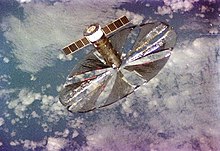
Space mirrors are satellites that are designed to change the amount of solar radiation that impacts the Earth as a form of climate engineering. The concept was first theorised in 1923 by physicist Hermann Oberth[1][2][3][4] and later developed in the 1980s by other scientists.[5] Space mirrors can be used to increase or decrease the amount of solar energy that reaches a specific point of the earth for various purposes. They have been theorised as a method of solar geoengineering by creating a space sunshade to deflect sunlight and counter global warming.[5][6]
There have been several proposed implementations of the space mirror concept but none have been implemented thus far other than the Znamya project by Russia due to logistical concerns and challenges of deployment.[5][7]
- ^ Oberth, Hermann (1984) [1923]. Die Rakete zu den Planetenräumen (in German). Michaels-Verlag Germany. pp. 87–88.
- ^ Oberth, Hermann (1970) [1929]. ways to spaceflight. NASA. pp. 481–506. Retrieved 21 December 2017 – via archiv.org.
- ^ Oberth, Hermann (1957). Menschen im Weltraum (in German). Econ Duesseldorf Germany. pp. 125–182.
- ^ Oberth, Hermann (1978). Der Weltraumspiegel (in German). Kriterion Bucharest.
- ^ a b c Kaufman, Rachel (August 8, 2012). "Could Space Mirrors Stop Global Warming?". Live Science. Retrieved 2019-11-08.
- ^ Sánchez, Joan-Pau; McInnes, Colin R. (2015-08-26). "Optimal Sunshade Configurations for Space-Based Geoengineering near the Sun-Earth L1 Point". PLOS ONE. 10 (8): e0136648. Bibcode:2015PLoSO..1036648S. doi:10.1371/journal.pone.0136648. ISSN 1932-6203. PMC 4550401. PMID 26309047.
- ^ "Znamya Space Mirror". 2006-08-08. Archived from the original on 2006-08-08. Retrieved 2019-11-08.